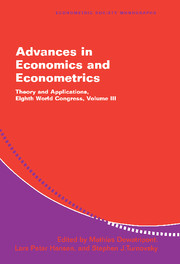Book contents
- Frontmatter
- Contents
- List of Contributors
- Preface
- 1 Contracting Constraints, Credit Markets, and Economic Development
- 2 Factor Models in Large Cross Sections of Time Series
- 3 Macroeconomic Forecasting Using Many Predictors
- “Big Data” Dynamic Factor Models for Macroeconomic Measurement and Forecasting: A Discussion of the Papers by Lucrezia Reichlin and by Mark W. Watson
- 4 How Severe Is the Time-Inconsistency Problem in Monetary Policy?
- 5 New Perspectives on Monetary Policy, Inflation, and the Business Cycle
- Comments on Papers by Stefania Albanesi, V. V. Chari, and Lawrence J. Christiano and by Jordi Galí
- 6 Consumption Smoothing and Extended Families
- 7 Computational Methods for Dynamic Equilibria with Heterogeneous Agents
- Index
7 - Computational Methods for Dynamic Equilibria with Heterogeneous Agents
Published online by Cambridge University Press: 06 January 2010
- Frontmatter
- Contents
- List of Contributors
- Preface
- 1 Contracting Constraints, Credit Markets, and Economic Development
- 2 Factor Models in Large Cross Sections of Time Series
- 3 Macroeconomic Forecasting Using Many Predictors
- “Big Data” Dynamic Factor Models for Macroeconomic Measurement and Forecasting: A Discussion of the Papers by Lucrezia Reichlin and by Mark W. Watson
- 4 How Severe Is the Time-Inconsistency Problem in Monetary Policy?
- 5 New Perspectives on Monetary Policy, Inflation, and the Business Cycle
- Comments on Papers by Stefania Albanesi, V. V. Chari, and Lawrence J. Christiano and by Jordi Galí
- 6 Consumption Smoothing and Extended Families
- 7 Computational Methods for Dynamic Equilibria with Heterogeneous Agents
- Index
Summary
INTRODUCTION
Computational methods have become increasingly important in the analysis of dynamic general equilibrium problems. These methods are being used, for example, to study the incidence of tax and monetary policies in dynamic models of growth, commodity storage inv arious models of agricultural commodity markets, and price formationindyn amic models of asset markets. Many early computational methods relied primarily on intuitive economic tatonnement stories, and produced moderately successful algorithms. Even when these methods worked, they were usually slow. Furthermore, as we know from general equilibrium theory, tatonnement methods may not converge even with good initial guesses. Inthe past decade, the computational literature has made more use of formal mathematical tools from numerical analysis and perturbation theory. This use has resulted inmore powerful algorithms that canattack increasingly complex problems. These developments are particularly important when we try to solve models with several agents. This essay reviews the key ideas used in recent work, gives some examples of their advantages, and indicates the likely directions future work will take.
It is particularly appropriate that the 2000 World Congress of the Econometric Society include a survey of recent computational literature, because computational methodology is inherently an important part of what is broadly called “econometrics.” Ragnar Frisch, in his editorial in the initial issue of Econometrica, defined econometrics as the “unification of the theoretical-quantitative and the empirical-quantitative approach to economic problems.”
- Type
- Chapter
- Information
- Advances in Economics and EconometricsTheory and Applications, Eighth World Congress, pp. 243 - 290Publisher: Cambridge University PressPrint publication year: 2003
- 15
- Cited by



